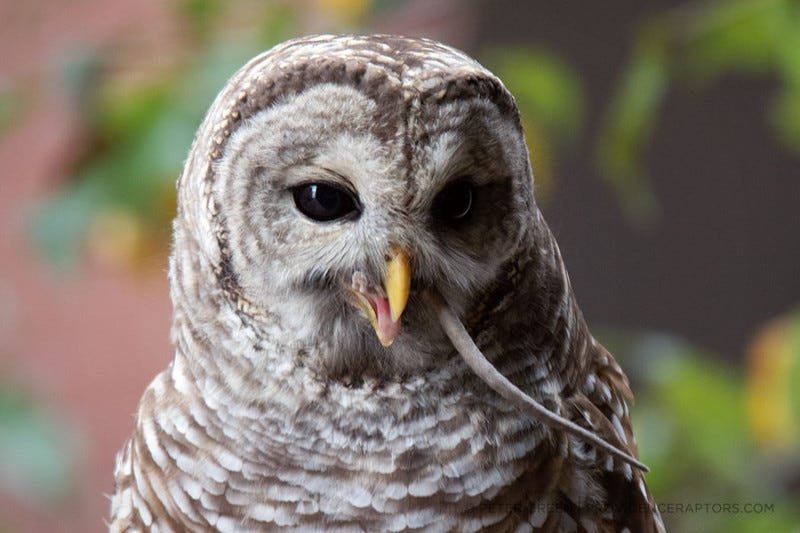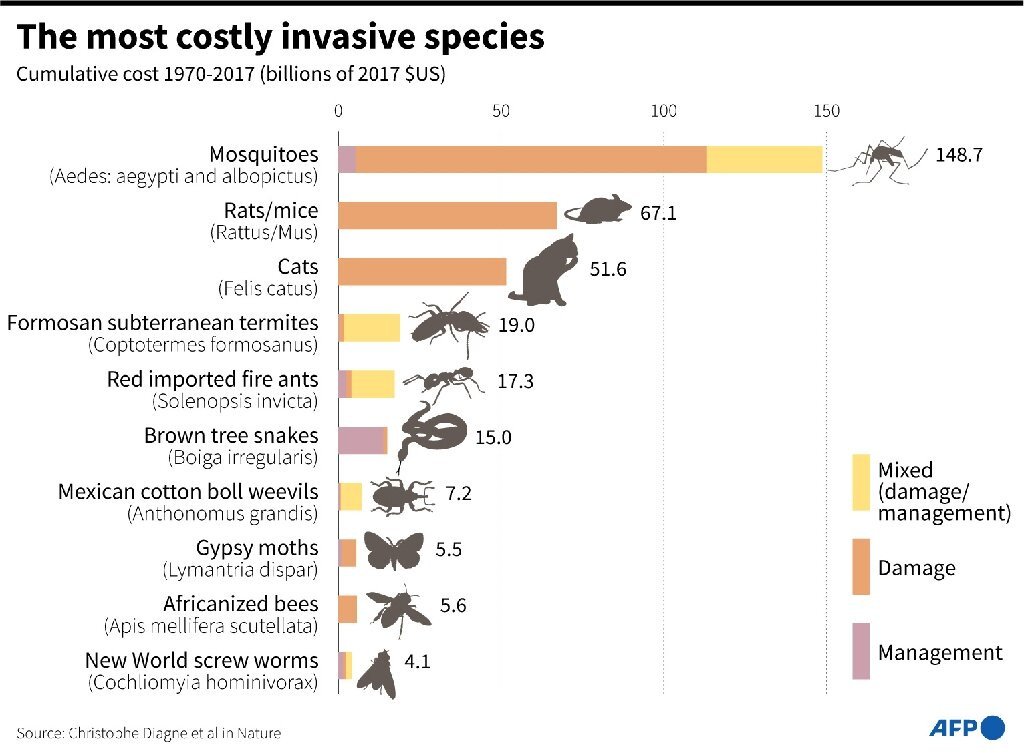Shade Good, Rats Bad
How to plant a beautiful urban yard that deters rats
Photographer Peter Green captured this barred owl eating a rat (Source: Providence Raptors)
Dear Avant Gardener, What groundcovers do you recommend for my shady back and side yards? I don’t spend time there because nothing grows on the ground and — full disclosure — my lot backs onto a cafe that attracts rats. There is ivy at the base of the house and some grass in the northwest corner, which gets morning sun. — Not Making It in the Shade, Providence, Rhode Island
Eek! Rip out that ivy right away! It’s a magnet for rats. But as much as I detest rats, what really angers me is writers who promote the myth that nothing grows in shade.
To wit, a recent article in the Washington Post:
Even a shade-loving perennial won’t thrive if it doesn’t receive its own light, water and nutrients. Mulch with bark directly beneath large trees, leaving the area free of plants. — Washington Post
Not true. I mean, does a bear sh*t in the woods? Of course! And when he does he’s surrounded by vegetation growing beneath the tree canopy.
The myth of full sun
The myth that full sun is needed for plants to thrive must derive from the common misapplication of agricultural practices to horticulture. And it’s promulgated by mow-and-blow operations because putting a deep bed of mulch under a tree is easier and cheaper than planting there.
Why is this important? Because in a warming world, we need more trees and their shade to keep temperatures down.
Trees and vegetation lower surface and air temperatures by providing shade and through evapotranspiration. Shaded surfaces, for example, may be 20–45°F cooler than the peak temperatures of unshaded materials. Evapotranspiration, alone or in combination with shading, can help reduce peak summer temperatures by 2–9°F. — EPA
In addition, the lifecycle of many moth and butterfly species involves the caterpillar falling from a tree onto vegetation below. And the lifecycle of most terrestrial birds involves feeding their young hundreds of caterpillars a day; no caterpillars, no birds.
It’s true, trees like invasive Norway maple — especially when grown isolated in a sea of lawn – cast deep shade and have extensive, shallow roots. But this is the exception, not the rule. Woodland plants have adaptations that enable them to survive with little direct light. For example, perennials like mayapple and Canadian mayflower grow rapidly in early spring before trees leaf out.
Deterring rats
In fact, the Lady Bird Johnson Wildflower Center’s database identifies 387 Rhode Island native plants that grow in less than two hours of sunlight a day. Unfortunately, most are unsuitable for your backyard because of — here they come — the rats. Here are some tips for yards located near a rat infestation:
1. Rip out ivy and similar groundcovers
Rats — as well as many beneficial species — use plants for cover and make their nests in them. Rats especially love to make nests around the roots of ivy, a phenomenon I unfortunately witnessed firsthand when rats infested my Manhattan neighbor’s container garden. According to a report published by the San Francisco Department of the Environment,
Several species of ivy, including the common English ivy (Hedera helix) as well as other common ground covers such as Pachysandra and Liriope spp., are known to provide an ideal habitat for rats, and plantings adjacent to buildings dramatically increase the chance of rat infestations. — Pest Prevention by Design
The report also advises against Algerian or English ivy, star jasmine, and honeysuckle on fences or buildings, as well as plants that shed seeds and fruits.
2. Maintain neat, mown groundcover
I generally recommend treating lawns as area rugs and limiting them to areas for paths, play, and pets. That’s because my readers and I want to maximize habitat for threatened wildlife. When there’s a rat infestation nearby, creating habitat near your house invites a health hazard. Keeping a neat, mown yard makes it inhospitable to rats and allows you to see any burrows. More severe infestations even benefit from a three-foot vegetation-free zone around residences, as recommended in the Providence Rodent Prevention Guide.
3. Eliminate the infestation at its source
Long before New York’s Soho became a tourist destination, my loft overlooked Broome Street to a tofu factory on the other side. Each time I looked out the windows at night I saw several rats running across the street. I suffered a lot of rat-related anxiety before I eventually called New York City’s pest line to report the infestation and posted signs asking my neighbors to do the same. The rats disappeared.
New York still sends out health inspectors in response to citizen complaints about restaurants and other businesses. That hasn’t stopped the city’s rat problem from getting so bad that Mayor Adams recently appointed a rat tsar. Providence doesn’t have a formal rat complaint procedure (a good sign?), but the operator who responded to my 311 call (401-421-2489) offered to file a complaint for a licensed business.
It’s likely that the infestation behind you is at the cafe’s dumpster, not inside. In a discussion about how common rats are in restaurants, many food service employees agreed they are rare in a well-run operation. However, as one respondent put it,
No, not all restaurants have rats in the kitchen. All restaurants have rats by the dumpsters. — Reddit
IMHO, it’s worth checking out the cafe dumpsters to make sure their lids and bases are tightly sealed. (See the DC department of health’s dumpster details.) You can speak with the cafe owner and/or the waste management company about having those in disrepair replaced. Our Providence yard backed onto the parking lot of a tony club; I complained to the chef about the odor when employees left the dumpster lids open and they generally made a greater effort to close them.
4. Consider humane rat traps
“Build a better mousetrap, and the world will beat a path to your door" paraphrases something Ralph Waldo Emerson said more than 150 years ago. And people are still trying. Most recently, a New Zealand company developed a device that uses carbon dioxide to propel a motion-activated striker to instantaneously kill rodents. Shawn Woods, host of Mousetrap Monday, told Wirecutter it was among the best he tried. It was too expensive to earn a best mousetrap recommendation, but it’s worth checking out the A24 Rat Trap .
Back to plants for shade
So, back to your questions: What to plant in your shady and partly moist yard? My top choices for a mowable, walkable lawn in shade is a mix of native violets (Viola sororia), American self-heal (Prunella vulgaris), and grasslike Pennsylvania sedge (Carex pensylvanica) in dry shade and James’ sedge (Carex Jamesii) in moist shade. The violets and sedges are best planted as plugs (young, deep-rooted plants); you can seed the self-heal in the fall.
In addition, consider planting a couple of small, flowering understory trees for additional visual interest. Some favorites are serviceberry (Amelanchier canadensis) and flowering dogwood (Cornus florida).
Finally, if you’re feeling experimental and want to add a naturalistic touch, then plant a border of ramps (Allium tricoccum) in the shady area and wild chives (Allium schoenoprasum), which have lovely purple flowers, in the sunny area. Rats dislike the smell of garlics, so there’s a chance the fragrance of these perennials may deter them. You could continue the theme in any sunny areas with their striking and long-flowering relative, nodding onion (Allium cernuum; native as far east as New York State).
See images and related resources below. In Rhode Island, you can find the plants at Prickly Ed’s.
Happy planting!
— The Avant Gardener
Why, How, Wow!
Why?
Rats are the second costliest invasive species worldwide — after mosquitoes and ahead of cats. They transmit more than 35 diseases to humans, extinguish native species, and destroy crops.
Disease-carrying mosquitoes, crop-ravaging rodents, forest-eating insects and even the domestic cat are all "exotic" intruders whose cost to humanity and the environment is vast and growing, according to a sweeping study published [in Nature]. — Phys.org
And invasive species generally are among the top five causes of environmental destruction, outcompeting beneficial native species.
The UN's science advisory panel for biodiversity . . . has said invasive species are among the top five culprits—all human-driven—of environmental destruction worldwide, along with changes to land use, resource exploitation, pollution and climate change. — Phys.org
Altogether, invasive species control costs worldwide total an estimated $1.3 trillion.
How
Please don’t use rodenticides to eliminate rats. Called “a modern-day DDT” by the Humane Gardener, these poisons weaken rats before they kill them, making them easy prey for all sorts of wildlife. And when an owl or bobcat eats a poisoned rat, they die, too.
Owls and snakes make better ratters than cats, by the way. Not only do outdoor cats kill billions of bird each year, their rat-catching abilities are overrated.
The well-known rodentologist Bill Jackson found in 1951 that Baltimore cats did nothing more than catch rats that would eventually die from one cause or another anyway. Their predation had not reduced the rodent population. More recently in 1986, Dr. J. Childs conducted research on city cats and rats that found a size-dependent selection of rats by cats, whereby cats will catch only juvenile or sub-adult rats, and do not complete their chases of adult rats. He observed, “although adult cats and larger rats were frequently observed in close proximity, no aggressive behavior was directed by rats toward cats, and generally these species co-exist peacefully in alleys.” — Pest Control Technology
Wow!
These are all great Northeast native plants for shade.
Natives for a tapestry lawn in shade: common violets, American self-heal, Pennsylvania sedge, and James' sedge
Small native trees for shade: flowering dogwood and serviceberry
Native alliums: nodding onion, chives, ramps
Related Resources
Curious why cats are considered invasive? Read Cat Love Can Kill.
What’s your lawn impact? Try my lawn care, the environment, and our ecosystem self-assessment.
Want to learn more about turf alternatives? Read The New American Lawn.






